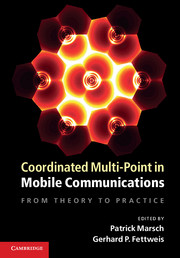Book contents
- Frontmatter
- Contents
- List of Contributors
- Acknowledgements
- List of Abbreviations
- Nomenclature and Notation
- Part I Motivation and Basics
- Part II Practical CoMP Schemes
- Part III Challenges Connected to CoMP
- 7 Clustering
- 8 Synchronization
- 9 Channel Knowledge
- 10 Efficient and Robust Algorithm Implementation
- 11 Scheduling, Signaling and Adaptive Usage of CoMP
- 12 Backhaul
- Part IV Performance Assessment
- Part V Outlook and Conclusions
- References
- Index
7 - Clustering
from Part III - Challenges Connected to CoMP
Published online by Cambridge University Press: 05 August 2012
- Frontmatter
- Contents
- List of Contributors
- Acknowledgements
- List of Abbreviations
- Nomenclature and Notation
- Part I Motivation and Basics
- Part II Practical CoMP Schemes
- Part III Challenges Connected to CoMP
- 7 Clustering
- 8 Synchronization
- 9 Channel Knowledge
- 10 Efficient and Robust Algorithm Implementation
- 11 Scheduling, Signaling and Adaptive Usage of CoMP
- 12 Backhaul
- Part IV Performance Assessment
- Part V Outlook and Conclusions
- References
- Index
Summary
As mentioned in previous chapters, CoMP has the capability to significantly enhance spectral efficiency and cell-edge throughput. However, CoMP may require additional signaling overhead on the air interface and the backhaul, in particular joint signal processing CoMP as introduced in Chapter 6. Therefore, in practice only a limited number of base stations can cooperate in order to keep the overhead manageable. This raises the question which base stations should form cooperation clusters in order to exploit the advantages of CoMP efficiently at limited complexity.
In general, one can distinguish between static and dynamic clustering algorithms. Static clusters are kept constant over time and designed based on geographical criteria as the positions of base stations and the morphology of the surroundings. In the case of dynamic clustering, the system continuously adapts the clustering strategy to changing parameters such as user equipment (UE) locations and radio frequency (RF) conditions. Here, the central question is on which information the adaptation of clusters shall be based, and where in the system clustering decisions are made.
To illustrate concrete clustering results and their corresponding performance, we use two different setups in this chapter. On one hand, we consider an idealistic setup, i.e. a hexagonal layout of up to M = 111 cells, grouped into sites of 3 cells each, with an inter-site distance (ISD) of 500 m.
- Type
- Chapter
- Information
- Coordinated Multi-Point in Mobile CommunicationsFrom Theory to Practice, pp. 139 - 160Publisher: Cambridge University PressPrint publication year: 2011
- 5
- Cited by



